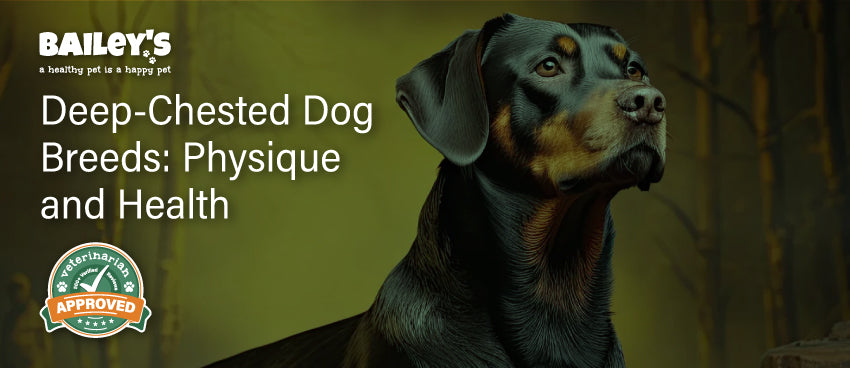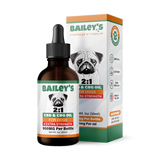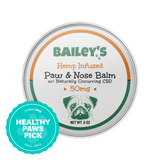Deep-Chested Dog Breeds: Physique and Health

Deep-chested dog breeds are unique in their physique and health characteristics. Understanding their anatomy and the implications it has on their well-being is key to providing proper care for these breeds.

The friendly experts at Bailey’s CBD educate us on the physical characteristics of deep-chested dogs, common health issues they may face, a comprehensive list of breeds with deep chests, and important considerations for their care.
Table of Contents
- 1. Understanding the Anatomy of Deep-Chested Dog Breeds
- 2. The Health Implications of a Deep Chest in Dogs
- 2.1 Common Health Issues in Deep-Chested Breeds
- 2.2 The Link Between Deep Chests and Bloating in Dogs
- 3. Breeds with Deep Chests: A Comprehensive List
- 4. Caring for Deep-Chested Dog Breeds
- 5. Preventive Measures and Treatments for Deep-Chested Dogs
- 5.1 Regular Vet Check-ups and Their Importance
- 5.2 Understanding and Responding to Health Emergencies
- 6. Conclusion
1. Understanding the Anatomy of Deep-Chested Dog Breeds
Deep-chested dog breeds, as the name suggests, are characterized by a noticeably deeper chest compared to other dogs. This anatomical feature is primarily determined by the shape and positioning of their ribcage. The longer sternum and ribcage provide ample space for the vital organs housed within the chest cavity.
When we delve deeper into the anatomy of deep-chested dog breeds, we discover fascinating details about their internal structure. The ribcage of these breeds is not only longer but also broader, allowing for increased lung capacity. This enhanced lung capacity enables these dogs to have a higher oxygen intake, making them well-suited for activities that require endurance and stamina.
Moreover, the sternum of deep-chested dogs is more pronounced and extends further forward compared to other breeds. This extended sternum provides additional support and protection to the vital organs, such as the heart and lungs, which are nestled within the chest cavity. It acts as a shield, safeguarding these organs during physical activities and potential impacts.
1.1 Defining Deep-Chested Dog Breeds
When we refer to deep-chested dog breeds, we are encompassing a wide range of breeds including the Great Dane, Boxer, Doberman Pinscher, and Greyhound, among others. These breeds share similar characteristics in terms of their chest shape and internal structure.

Let's take a closer look at some of these breeds:
- Great Dane: Known for their impressive size and majestic appearance, Great Danes possess a deep chest that allows for efficient oxygen intake, supporting their massive bodies.
- Boxer: Boxers, with their muscular build and energetic nature, have a deep chest that contributes to their agility and endurance. This anatomical feature aids them in various tasks, including working as service dogs and participating in dog sports.
- Doberman Pinscher: Dobermans are renowned for their sleek and powerful physique. Their deep chest enables them to excel in activities that require speed and agility, such as obedience trials and agility competitions.
- Greyhound: As one of the fastest dog breeds, Greyhounds possess a deep chest that accommodates their large heart and lungs. This anatomical advantage allows them to reach incredible speeds during races.
1.2 Physical Characteristics of Deep-Chested Dogs
In addition to their deeper chests, deep-chested dog breeds often have a narrow waistline and a lean and athletic physique. This unique combination of physical traits enables them to excel in specific tasks, such as endurance activities and speed-related tasks.
The narrow waistline of deep-chested dogs is a result of their ribcage tapering towards the abdomen. This streamlined shape reduces drag and enhances their ability to move swiftly. It is this combination of a deep chest, narrow waistline, and lean physique that contributes to their remarkable agility and speed.
Furthermore, deep-chested dogs typically have well-developed muscles throughout their bodies. Their strong and flexible muscles, combined with their deep chest, provide them with the power and strength required for various physical activities. Whether it's running, jumping, or participating in dog sports, these breeds are built for performance.
It is important to note that while deep-chested dog breeds possess unique anatomical features that make them excel in certain areas, they also require special care and attention. Their deep chests make them more prone to certain health issues, such as bloat, which is a life-threatening condition. Therefore, owners of deep-chested dogs must be alert and aware of these risks and take appropriate measures to ensure their well-being.
2. The Health Implications of a Deep Chest in Dogs
The deep chest of these breeds can have both advantages and certain health risks. Understanding these implications is crucial for maintaining their overall well-being.

Deep-chested dogs, such as the Great Dane, Doberman Pinscher, and Weimaraner, possess a unique physique that sets them apart from other breeds. Their elongated ribcage and spacious chest cavity provide several benefits, including increased lung capacity and improved endurance. This anatomical advantage makes them well-suited for activities that require sustained physical exertion, such as running, hiking, and agility training.
2.1 Common Health Issues in Deep-Chested Breeds
While the deep chest of these breeds offers numerous advantages, it also comes with certain health risks that owners should be aware of. One of the most common problems is gastric dilatation-volvulus (GDV), commonly known as bloat. This condition occurs when the stomach twists, leading to a blockage of blood flow and potentially fatal consequences.
Bloat is a serious and life-threatening condition that requires immediate veterinary attention. It can occur suddenly and progress rapidly, making it crucial for owners of deep-chested breeds to be vigilant and familiarize themselves with the early signs of bloat. Symptoms may include restlessness, unproductive attempts to vomit, a distended abdomen, and signs of discomfort or pain.
Related Dog Digestive Health Article🐕🦺:
Bloating in Dogs: Causes, Symptoms, and CBD ReliefIn addition to GDV, deep-chested breeds may also be susceptible to heart problems, certain types of cancer, and respiratory issues. While these conditions are not exclusive to deep-chested breeds, their unique anatomy may predispose them to a higher risk. Regular vet check-ups and vigilance are essential in detecting and addressing these health concerns early on.
2.2 The Link Between Deep Chests and Bloating in Dogs
The deep chest of these breeds has been identified as a contributing factor to the development of bloat. The larger chest cavity allows for increased gas accumulation, and combined with other factors such as exercise after meals and fast eating habits, the risk of bloat is heightened.
When a dog with a deep chest exercises vigorously after a meal, the movement can cause the stomach to rotate or twist, leading to a blockage of blood flow. This twisting not only traps gas and food in the stomach but also prevents the release of built-up pressure. As a result, the stomach becomes distended, putting pressure on nearby organs and compromising their function.
Fast eating habits can also contribute to the development of bloat in deep-chested breeds. When a dog consumes food too quickly, they are more likely to swallow air, which can further increase the risk of gastric dilatation-volvulus. To minimize this risk, owners can use specialized slow-feed bowls or feed their dogs smaller, more frequent meals throughout the day.
While the link between deep chests and bloat is well-established, it is important to note that not all deep-chested dogs will develop this condition. However, understanding the potential risks and taking preventive measures can greatly reduce the likelihood of bloat and other associated health issues.
3. Breeds with Deep Chests: A Comprehensive List
When it comes to dogs, many factors make each breed unique. One such characteristic is the depth of their chests. A deep chest not only adds to a dog's physical appearance but also plays a crucial role in their overall health and well-being. In this comprehensive list, we will explore both large and small breeds that possess this distinctive feature.
3.1 Large Breeds with Deep Chests
- Great Dane

Starting off our list is the majestic Great Dane. Known for their towering height and gentle nature, Great Danes are a breed that commands attention wherever they go. Their deep chests provide ample space for their vital organs, allowing for efficient oxygen flow and healthy heart function.
- Irish Wolfhound

The Irish Wolfhound, with its long history dating back to ancient times, is a breed that possesses both strength and grace. Their deep chests are a testament to their endurance and stamina, making them excellent companions for long walks or runs.
- Saint Bernard

The Saint Bernard, famous for its role as a rescue dog in the Swiss Alps, is a breed that is as gentle as it is powerful. Their deep chests enable them to have a robust lung capacity, making them well-suited for high-altitude environments.
- Rhodesian Ridgeback

The Rhodesian Ridgeback, originally bred as a hunting dog in Africa, is known for its distinctive ridge of hair along its back. Along with their muscular build, their deep chests allow for efficient breathing during intense physical activities.
- Weimaraner

Rounding off our list of large breeds with deep chests is the Weimaraner. With their sleek silver coats and striking blue eyes, Weimaraners are not only beautiful but also highly energetic. Their deep chests aid in their endurance, making them excellent companions for outdoor adventures.
3.2 Small Breeds with Deep Chests
- Boxer

Despite their compact size, Boxers are a small breed that packs a punch. Their deep chests contribute to their agility and speed, allowing them to excel in various dog sports such as agility and obedience.
- Doberman Pinscher

The Doberman Pinscher, known for its loyalty and protective nature, is a breed that possesses both elegance and strength. Their deep chests provide ample room for their powerful heart and lungs, enabling them to excel in activities that require endurance.
- Greyhound

The Greyhound, often associated with speed and grace, is a breed that is built for running. Their deep chests, combined with their slender bodies, allow for maximum lung expansion, making them one of the fastest dog breeds in the world.
- Whippet

Similar to the Greyhound, the Whippet is a small breed that excels in speed and agility. Their deep chests contribute to their efficient oxygen intake, enabling them to reach impressive speeds during sprints.
- Dalmatian

Last but not least, we have the Dalmatian. Known for their unique coat pattern and playful nature, Dalmatians are a breed that thrives on physical activity. Their deep chests provide ample space for their lungs to expand, allowing them to keep up with their energetic lifestyle.
As you can see, breeds with deep chests come in all shapes and sizes. Whether large or small, these breeds possess this distinctive feature that not only adds to their physical appearance but also contributes to their overall health and well-being.

4. Caring for Deep-Chested Dog Breeds
Providing proper care for deep-chested breeds goes beyond their physical characteristics. Here are some essential considerations:
4.1 Dietary Considerations for Deep-Chested Dogs
Due to their increased risk of bloating, it is crucial to provide deep-chested dogs with a diet that suits their specific needs. Feeding smaller, more frequent meals and using slow-feed bowls can help prevent bloat. Additionally, avoiding exercise immediately before and after meals is recommended.
4.2 Exercise and Activity Recommendations
Regular exercise is important for all dogs, but it is particularly beneficial for deep-chested breeds. Engaging in activities such as walking, jogging, or agility training can help maintain their overall health and prevent weight gain. However, it is vital to avoid intense exercise immediately after meals to minimize the risk of bloat.
5. Preventive Measures and Treatments for Deep-Chested Dogs
Prevention and prompt treatment are key to ensuring the well-being of deep-chested dog breeds. Here are some essential measures:
5.1 Regular Vet Check-ups and Their Importance
Schedule regular check-ups with your veterinarian to monitor your deep-chested dog's health. These visits allow for early detection of potential issues and ensure appropriate preventive measures are in place. Your vet may also recommend specific tests or screenings based on the breed's predispositions. Your dog’s favorite veterinarian can also provide wisdom on the best food, treats, and supplements for a long and happy life for your furry friend.
5.2 Understanding and Responding to Health Emergencies
It is crucial to familiarize yourself with the signs and symptoms of potential health emergencies that deep-chested dog breeds may face. Prompt recognition and appropriate actions can make a significant difference in their outcome. Consult your veterinarian for guidance and ensure you have a first aid kit readily available.











